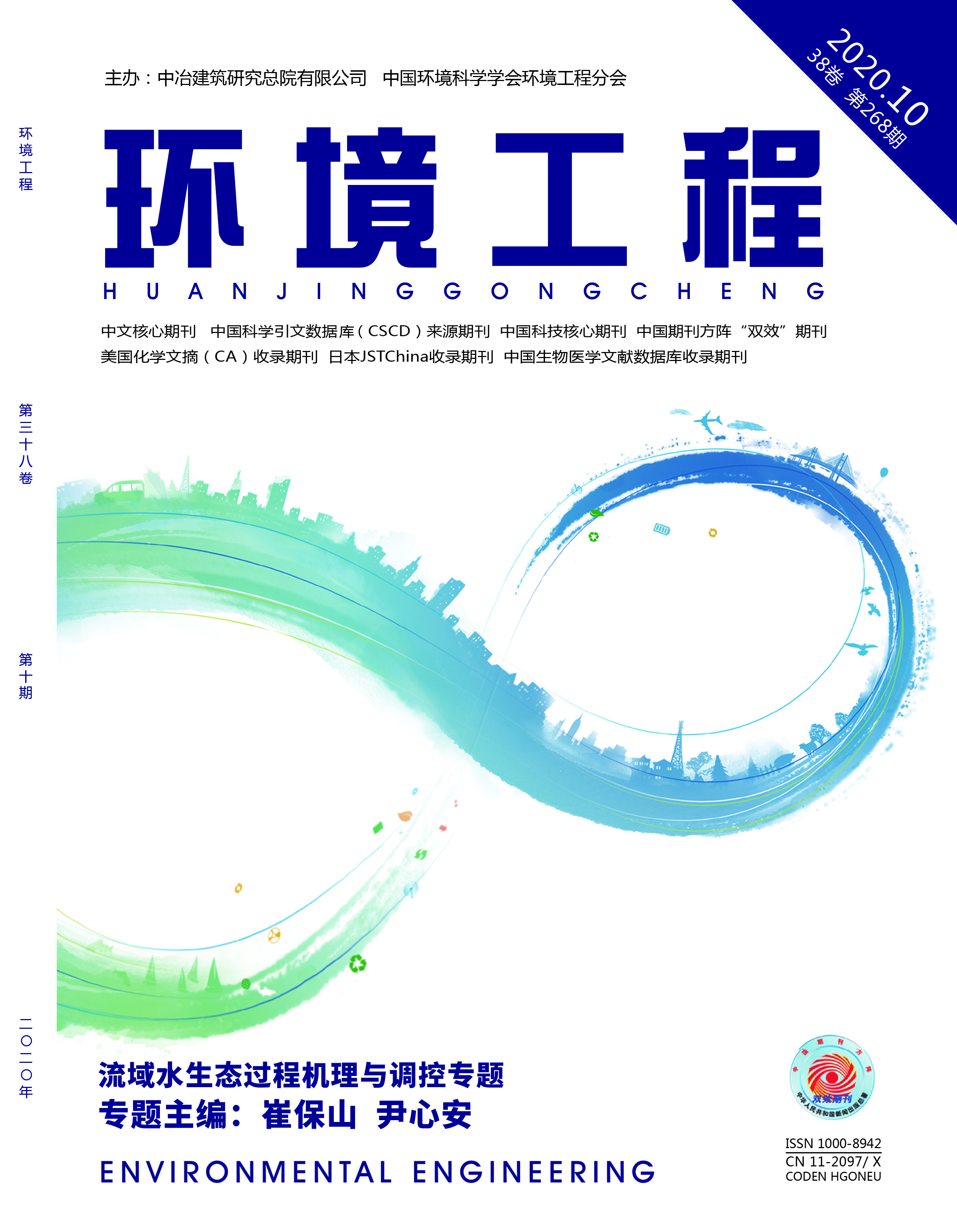|
中国环境保护部. 中国环境统计年鉴[M]. 北京:中国统计出版社,2017.
|
|
FENG L Y, LUO J Y, CHEN Y G. Dilemma of sewage sludge treatment and disposal in China[J]. Environmental Science & Technology, 2015,49(8):4781-4782.
|
|
范世锁,汤婕,程燕,等. 污泥基生物炭中重金属的形态分布及潜在生态风险研究[J]. 生态环境学报,2015,24(10):1739-1744.
|
|
BALWANT S, BHUPINDERPAL S, ANNETTEL C. Characterisation and evaluation of biochars for their application as a soil amendment[J]. Australian Journal of Soil Research, 2010, 48(7):516-525.
|
|
DE ANDRÉS J M, ORJALES L, NARROS A, et al. Carbon dioxide adsorption in chemically activated carbon from sewage sludge[J]. Journal of the Air & Waste Management Association, 2013, 63(5):557-564.
|
|
MUHAMMAD R, SHAFAQAT A, MUHAMMAD M F, et al. Mechanisms of biochar-mediated alleviation of toxicity of trace elements in plants:a critical review[J]. Environmental Science & Pollution Research, 2016. 23(3):2230-2248.
|
|
王格格,李刚,陆江银,等. 热解工艺对污泥制备生物炭物理结构的影响[J]. 环境工程学报,2016,10(12):7289-7293.
|
|
陈坦,韩融,王洪涛,等. 污泥基生物炭对重金属的吸附作用[J]. 清华大学学报(自然科学版),2014,54(8):1062-1067.
|
|
陈坦,周泽宇,孟瑞红,等. 改性污泥基生物炭的性质与重金属吸附效果[J]. 环境科学,2019,40(4):1842-1848.
|
|
王君,陈娴,桂丕,等.污泥炭化温度和时间对重金属形态及作物累积的影响[J]. 华南农业大学学报,2015,36(5):54-60.
|
|
金俊伟. 热解及添加生物质辅料对污泥中重金属的固定效应及生态风险评价[D]. 杭州:浙江农林大学,2016.
|
|
潘亭亭,张双全,张秋荣,等. 城市污泥与玉米秸秆共热解重金属的形态变化[J]. 中国矿业大学学报,2011,40(3):487-491.
|
|
卢欢亮,叶向东,汪永红,等. 热解温度对污泥生物炭的表面特性及重金属安全性的影响[J]. 环境工程学报,2015,9(3):1433-1439.
|
|
王志朴,朱赫男,邢文龙,等. 污泥与秸秆共热解制备生物炭工艺优化及其对Cr(Ⅵ)的吸附[J]. 环境工程,2019,37(2):138-143.
|
|
赵晶晶,周少奇,陈安安,等. 城市污泥与花生壳制活性炭的重金属形态分析及生态风险评价[J]. 农业环境科学学报,2012,31(11):2284-2289.
|
|
刘立恒,林华,李海翔,等.污泥活性炭的制备、表征及应用[M].北京:中国环境出版社,2017.
|
|
LI Z, DENG H, YANG L, et al. Influence of potassium hydroxide activation on characteristics and environmental risk of heavy metals in chars derived from municipal sewage sludge[J]. Bioresource Technology, 2018, 256:216-223.
|
|
CHEN T, YAN B. Fixation and partitioning of heavy metals in slag after incineration of sewage sludge[J]. Waste Management, 2012, 32(5):957-964.
|
|
EDGELL K.US EPA Method Study 37-SW-846 Method 3050 Acid Digestion of Sediments Sludges and Soils[M]. Washington DC:US Environment Protection Agency, Environmental Monitoring Systems Laboratory, 1989.
|
|
HU Y, CHEN G, MA W, et al. Distribution and contamination hazards of heavy metals in solid residues from the pyrolysis and gasification of wastewater sewage sludge[J].Journal of Residuals Science & Technology, 2016, 13(4):259-268.
|
|
YUAN H R, LU T, ZHAO D D, et al. Influence of temperature on product distribution and biochar properties by municipal sludge pyrolysis[J]. Journal of Material Cycles and Waste Management, 2013, 15(3):357-361.
|
|
周杨. 不同催化剂对微波热解污泥产物分布规律的影响研究[D]. 深圳:深圳大学,2016.
|
|
蔡攀,蒋绍坚,付国富,等. 重金属在油菜秆热解过程中的迁移规律[J].中南大学学报(自然科学版),2018,49(7):1808-1814.
|
|
CHEN F F, HU Y Y, DOU X M, et al. Chemical forms of heavy metals in pyrolytic char of heavy metal-implanted sewage sludge and their impacts on leaching behaviors[J]. Journal of Analytical and Applied Pyrolysis, 2015, 116:152-160.
|
|
HU Y Y, YANG F, CHEN F F, et al. Pyrolysis of the mixture of MSWI fly ash and sewage sludge for co-disposal:effect of ferrous/ferric sulfate additives[J]. Waste Management, 2018, 75:340-351.
|
|
XIONG Q, ZHOU M, LIU M J, et al. The transformation behaviors of heavy metals and dewaterability of sewage sludge during the dual conditioning with Fe2+-sodium persulfate oxidation and rice husk[J]. Chemosphere, 2018, 208:93-100.
|
|
HE Y D, ZHAI Y B, LI C T, et al. The fate of Cu, Zn, Pb and Cd during the pyrolysis of sewage sludge at different temperatures[J]. Environmental Technology, 2010, 31(5):567-574.
|
|
HAN H D, HU S, SYED-HASSAN S S A, et al. Effects of reaction conditions on the emission behaviors of arsenic, cadmium and lead during sewage sludge pyrolysis[J]. Bioresource Technology, 2017, 236:138-145.
|
|
LU T, YUAN H R, WANG Y Z, et al. Characteristic of heavy metals in biochar derived from sewage sludge[J]. Journal of Material Cycles and Waste Management, 2016, 18(4):725-733.
|
|
李刚,王格格,王忠科,等. 脱水污泥低温热解制备生物炭的研究[J]. 可再生能源,2016,34(10):1533-1539.
|
|
LI H M, QIAN X, HU W, et al. Chemical speciation and human health risk of trace metals in urban street dusts from a metropolitan city, Nanjing, SE China[J]. Science of The Total Environment, 2013, 456-457(7):212-221.
|
|
张进,刁韩杰,王敏艳,等.稻壳与污泥共热解对污泥炭特性及其重金属生态风险的影响[J].环境科学学报,2019,39(4):1250-1256.
|
|
BING H J, ZHOU J, WU Y H, et al.Current state, sources, and potential risk of heavy metals in sediments of Three Gorges Reservoir, China[J]. Environmental Pollution, 2016, 214:485-496.
|
|
杨刚. 高灰基生物炭农用对镉污染的控制机制及生态风险评价[D]. 南京:南京大学,2018.
|
|
LIU X X, WANG Y W, GUI C M, et al. Chemical forms and risk assessment of heavy metals in sludge-biochar produced by microwaveinduced low temperature pyrolysis[J]. RSC Advances, 2016, 6:101960-101967.
|


 Login
Login Register
Register E-alert
E-alert






 DownLoad:
DownLoad: